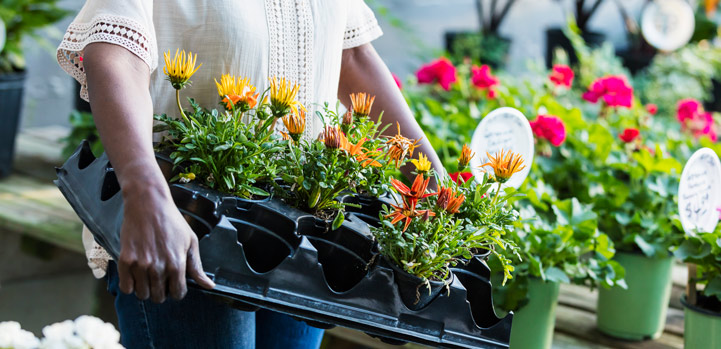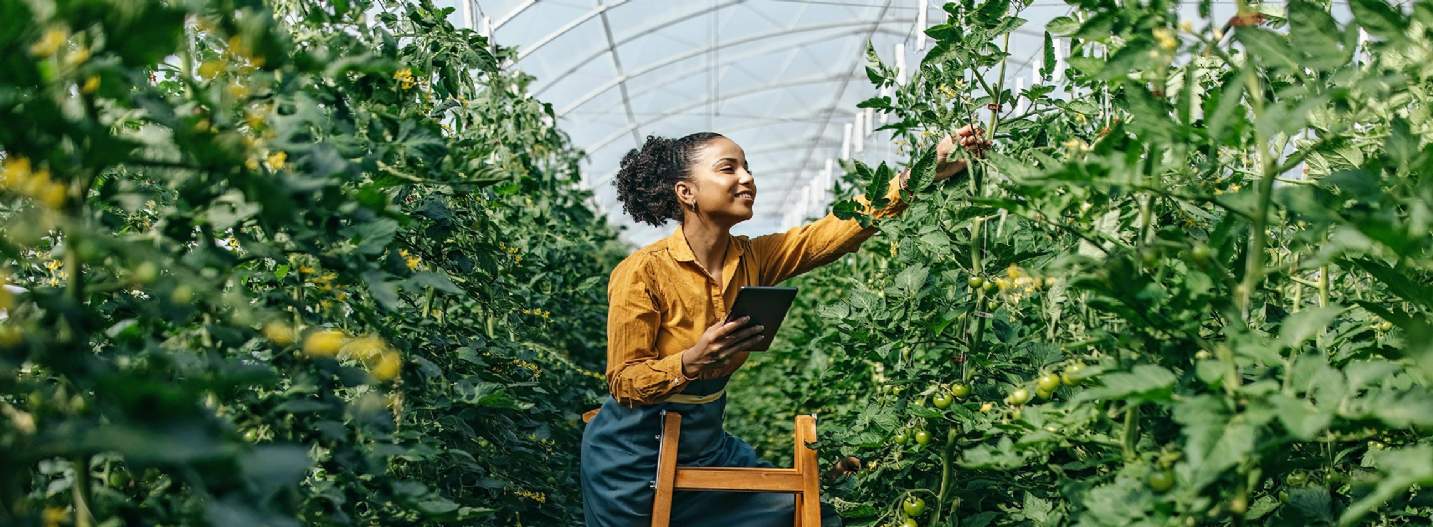Despite ongoing operational cost pressures and subdued trade during the first half of the year, improvements within the macroeconomic environment coupled with temperature rises in the UK increased garden-related spend by mid-year
Market update
Following two strong Covid-influenced years, many operators within the garden centre market started to accumulate an abundance of excess stock, which has continued into 2024 due to poor weather conditions. The first half of the year saw subdued retail sales, with wet weather coupled with ongoing cost of living pressures in April and May having a negative influence on the garden centre market, thus preventing operators from shifting legacy stock from the previous year. Summer temperatures were then slow to increase, a factor which heavily influences garden centre trade. That said, non-gardening categories were thriving by mid-year, with the GCA’s Barometer of Trade for June reporting increased sales compared to the same month in 2023 in catering (+19%), food hall/farm shop (+15%) and houseplants (+15%), but with outdoor plants (-2%) and furniture/BBQs down (-20%) due to poor weather.
After an earlier-than-anticipated election and the start of interest rate cuts, we are now beginning to see the initial signs of economic recovery, with consumer sentiment beginning to stabilise. The climate for major purchases saw a 7-point uptick between June and July, and a 16-point increase overall since July 2023. This will likely be positive for operators as it could translate into increased footfall, in particular for garden centres due to the coupling of warmer weather in July and August.
Despite ongoing operational cost pressures and subdued trade for operators during the first half of the year, there has been notable transactional activity in the garden centre market throughout 2024 to date. Much of this seller activity has derived from smaller groups and single-site operators, with an influx of family-run businesses seeking retirement which has brought new centres to the market – which in some cases have been acquired by larger groups. For example, Yorkshire Garden Centres acquired Dean’s Garden Centres in February (adding to its portfolio sites in Tong, Tingley, Otley and Bingley), in addition to Blue Diamond’s acquisition of two sites (Woburn Sands and Willington) from the Frost’s Garden Centre portfolio in August. There will likely be further expansion from the larger groups such as British Garden Centres and Blue Diamond through mergers and acquisitions compared to new build sites, due to the time lag involved in opening new development sites coupled with a rise in construction costs of +30% since the pandemic. That said, Blue Diamond continues to develop its site on Scotch Corner, North Yorkshire which is due to open in 2026.
In 2024 Blue Diamond similarly became the UK's number one garden centre based on turnover at £308m (excluding VAT), compared to Dobbies at £278m. This has brought benefits to the operator with regard to buying power, but also partnerships such as National Trust have resulted in a high profile, particularly at The Chelsea Flower Show in May.

Occupational Costs
Operators continue to wrangle with high utility costs (which will increase further this year due to a 10% increase in the energy price cap), staff shortages and increasing wages; all of which hamper financial and operational efficiency. Savills analysed a sample of 20 garden centres nationwide and the largest operational costs included staffing, business rates, utilities and repairs/maintenance. Of the sample, wages typically consumed circa 21% of turnover in 2023, a 3% increase since 2021. Following the National Living Wage increase in April 2024, the HTA predicts that wages will consume closer to 30–40% of turnover following this increase.
Across the sample, gross profit margins varied by centre and were largely influenced by the mix of goods and concessions (Figure 2 gives insight into the largest concession operators in the market) and in particular by the size of the food and beverage offering, when run in-house.
Gross retail margins were typically in the 40–50% bracket and had improved since 2021, but food and beverage margins were evidenced as being much higher, in some instances up to 76%. This exemplifies how a large and successful restaurant or café offering could improve the blended gross margin at the centre substantially.
The sample demonstrated that the average proportion of income from cafés/restaurants had also increased over the period, although using the average does obscure variances in the proportion of income derived from a food and beverage offering, with some centres seeing substantial increases (where income had almost doubled) and others seeing a more negligible effect.
Despite these promising trends, the effect of rising operational costs is evidenced by pressure on net profit margins. Savills found that across the sample although gross profit margins had increased, net profit margins had decreased by circa -3.5% over the same period. This illustrates that in spite of top-line growth, profit margins are often being eroded by heightened operational costs in a challenging macroeconomic environment. That said, we are seeing signs that this is beginning to ease in 2024.

Future Trends
In the future, we are likely to see further consolidation by the regional operators and larger groups as more family-run centres are purchased, as running centres becomes a less feasible lifestyle for some given ongoing operational pressures. The out-of-town retail market remains strong, and demand for developmental land for retail and drive-through space in strategic locations may shorten the life span of some smaller centres. This, coupled with the new government’s plans to overhaul the planning system and trigger a development boom will put further pressure on locating housing development land, which may also reduce the life span of some smaller centres.
Garden centres are having an increasing role in the experimental destination space. It is likely larger operators will continue to invest in existing sites through diversification, as introductions of horticulture nurseries and leisure experiences including pick your own and soft play continue to drive footfall as operators recognise the synergy between different uses. Such uses are helping to attract the growing young family market and younger demographics to centres, thus expanding their client base.
We have collated a series of methods operators can implement to both save and make more money to improve their bottom line.
- Review business rates
Temporary reliefs ended in 2023 for retail, leisure and hospitality businesses, and so operators may not have focused until now on their assessments. Businesses are able to appeal their rateable value if they feel they are paying the wrong amount. Unless the new government changes the timetable, the next rating list will be 2026, with a valuation date of April 2024. Disclosing correct information when required for the list is imperative, and the duty to notify is also now incumbent on all occupiers. Savills can provide professional input on the requirements and processes and can help collate a challenge or appeal. - Data-led analytics
Utilising technology can bring a wealth of benefits to operators, including analysing the busiest trade periods and adjusting trading hours and staffing patterns accordingly, reducing waste through monitoring catering levels/demand, managing stock levels to prevent having surplus stock at the end of the season, and optimising search engines to highlight to internet shoppers when goods are in-stock to increase draw to stores. - Energy
Implementing energy-efficient practices can reduce utility costs, such as upgrading current systems and reducing the level of standby capacity. The Savills Energy team can help assist operators in curating bespoke methods of how to do this at their centres. Simple initiatives may be reflected in EPC ratings. - Strategic partnerships
Vacant space can cost operators in terms of business rates and utility costs, so they are increasingly partnering up with other operators in different markets, such as veterinary practices, children’s day nurseries and medical centres to alleviate these costs. Alternative uses commonly agree to longer than usual leases and, therefore, provide the freehold owner with secure, often index-linked, long-term income. The garden centre turnover also benefits from this, as customers of the alternative uses will often visit the centre/café. - Diversify income through concessions
The biggest operators in the market have diversified income streams through concession presence in their stores. Although the income from concessions is typically much lower per sq ft than the turnover that can be generated by a store. For larger centres, this helps diversify the offering, bring in new audiences and create a destination feel to a centre. The top concessions by total count include Maidenhead Aquatics, Cotton Traders and Pavers Shoes. The concession market attracts interest from a breadth of sectors, with Holland & Barrett trialling concession space in garden centres in 2024, with the first site in Oakham, Leicestershire. - Rent
By increasing turnover rent agreements, operators share the risk of down periods between landlords and operators while providing landlords with a potential upside in boom years. Although most agreements will include a base rent, ongoing fixed costs are somewhat minimised.
- Renewable energy
Introducing renewable energy methods to centres can reduce utility costs and generate power on-site. At Golden Hill Community Garden (Bristol), solar panels are used to power a water pump and provide electricity for lighting. Hydro-electric, ground source heat pumps, biomass boilers and wind turbines have also been installed across farms and gardens across the UK (Federation of City Farms and Community Gardens). Even on small sites, solar panels fitted to roofs can generate much of the site’s energy requirements without losing retail space. - Site diversification
Diversifying unused land can include low-intensive uses such as a sculpture park or well-being gardens that increase customer dwell times and provide a social quality to centres, improving ESG and community engagement. Higher intensive uses can also be implemented to give centres the appeal of a destination day out, with Visit Britain reporting tourism days visits were up 7% in 2023 compared to 2022. Examples include Blue Diamond, which has added a play barn, butchers and food hall to Fosseway Garden Centre, and Ruxley Manor Garden Centre in Kent, which has submitted a planning application for £1.5m of leisure activities, including an 18-hole adventure golf course and high ropes zip-line course. - Catering
Cafés are reported as being the number one concession that an operator would add in given the opportunity, and can account for a significant proportion of turnover. Food and beverage typically has a higher gross margin than retail, and offerings can add over £3,000 turnover per cover on average. Bringing the catering back in-house can ensure these profits are captured by operators. - Product and centre quality
Customers are cost-conscious but with a heightened focus on quality, so although upgrades to centres may be costly initially, these can increase footfall and onsite spend. Similarly, passing on costs to customers through upper-scale and environmentally friendly products helps drive turnover. Despite the cost of living squeeze, luxury goods have often proved to be inflation-proof, and millennials’ connections to brands should not be underestimated. - Customer engagement
A poll by Drapers revealed that 54% of 18–24 year olds would rather go to a garden centre than a nightclub. Operators should monopolise the diverse customer base by ensuring there are attractive product ranges for these groups, such as indoor plants or balcony-friendly plants, as younger demographics more commonly reside in rented accommodation without access to a garden. The RHS similarly predict ‘houseplants’ and ‘greening of grey spaces’ (including balconies and windowsills) to be a continued theme in 2024. Initiatives such as community gardens and growing in public spaces are gaining momentum and also demonstrate an avenue towards attracting a new client base.
